The Most Useful Rope Knots
for the Average Person to Know
Hitches
To see more details in the pictures, zoom in by holding down the CTRL key and pressing + several times.
Restore by holding down the CTRL key and pressing 0.
|
The
Home Page
describes some knotting terminology, and it explains a number of factors which affect the security of the knots that you tie. Always keep in mind that there are risks associated with ropes and knots, and the risks are entirely your own.
Site Map
Hitches
A "hitch" is a knot which is used when fastening a rope to something. A stricter definition is that a hitch has the ability to conform to the size and shape of the object to which it's tied.
My current preferences are the
Adjustable Grip Hitch
and the
Siberian Hitch.
For some "specialty" hitches, see the
Miscellaneous Knots
page.
Practice tying your favorite knots periodically (from different angles) so that you'll remember how to tie them when you need them.
Here are some hitches:
- Adjustable Grip Hitch
URL: http://daveroot.neocities.org/knots/Knots_Hitches.html#AdjustableGripHitch
This is a quick, easy, secure, and versatile hitch. I tend to wrap the working end twice around the main part of the rope, as in the pictures. But for more security and gripping power, make three wraps around the main part of the rope.
 -1 -1
 -2 -2
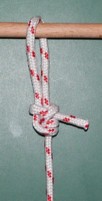 -3 -3
This knot is easy to tie, and it grips better than many other hitches. The beauty of this knot, and several other knots on this page, is that you can slide it up or down the rope (in order to tighten a tent rope, for example) and it will continue to grip wherever it's moved. The
Tarbuck Knot
and the
Tautline Hitch
(Midshipman's Hitch) are also good slide-and-grip knots, but in my experience they're not as easy to dress and set as the Adjustable Grip Hitch, and they don't seem to grip as well.
According to Budworth, "This practical slide-and-grip knot can be grasped and shifted easily by hand in either direction but locks up firmly under load. After the load is removed, the knot may be slid along the rope again. The momentum of a fall will cause the knot to slide and so absorb energy. ... Later tests involving 5.5-mm (1/4-in) Kevlar indicated that, when used as adjustable bends, these knots grip (i.e., do not slip) and break at around 80% of the absolute rupture load of the material used. This figure may be an underestimate."
(The Complete Book of Knots,
p.95).
To make it easier to untie, you can "slip" the knot. In other words, instead of passing the end of the rope through the knot when completing the knot, push a
bight
(a doubled rope) through instead. For more on "slipping" a knot, see the
Slip Knot.
- Back Hand Hitch or ABOK #1725
URL: http://daveroot.neocities.org/knots/Knots_Hitches.html#BackHandHitch
The Back Hand Hitch is an easy way to pass a rope once around an object and yet create two loops for a double hold on the object.
 -1 -1
 -2 -2
 -3 -3
 -4 -4
This is an easy way to form a double loop around an object for extra security. However, the drawback is that if it's not drawn up snugly then it might create a lot of friction where the rope rubs against itself, which can damage and weaken the rope. Also see the
Axle Hitch.
- Boa Knot
URL: http://daveroot.neocities.org/knots/Knots_Hitches.html#BoaKnot
Later I might add pictures for every hitch and binding knot which is related to the
Clove Hitch
and the
Constrictor Knot
and so on, but for now here's a link to the
Wikipedia article
about the Boa Knot.
- Boom Hitch
URL: http://daveroot.neocities.org/knots/Knots_Hitches.html#BoomHitch
Later I might add pictures for every hitch and binding knot which is related to the
Clove Hitch
and the
Constrictor Knot
and so on, but for now here's a link to the
Wikipedia article
about the Boom Hitch.
- Buntline Hitch or ABOK #1711
URL: http://daveroot.neocities.org/knots/Knots_Hitches.html#BuntlineHitch
This is an example of tying a
Clove Hitch
around the main part of the rope, and it's essentially a reversed
Two Half Hitches.
 -1 -1
 -2 -2
Since the second Half Hitch that you tie is jammed inside of the first Half Hitch, this is a more secure knot than
Two Half Hitches.
However, it can be difficult to untie unless it's "slipped" (for an example of "slipping" a knot, see the
Slip Knot).
- Camel Hitch or ABOK #215
URL: http://daveroot.neocities.org/knots/Knots_Hitches.html#CamelHitch
Later I might add pictures for every hitch and binding knot which is related to the
Clove Hitch
and the
Constrictor Knot
and so on, but for now here's a link to
an article
about the Camel Hitch.
- Clove Hitch or ABOK #1178
URL: http://daveroot.neocities.org/knots/Knots_Hitches.html#CloveHitch
The Clove Hitch is a popular hitch that's easy to tie, but it's not considered to be as secure as some of the other hitches. This is essentially
Two Half Hitches
tied around an object.
 -1 -1
 -2 -2
According to Budworth, "If pulled around, the clove hitch can work loose. Perversely, it can also jam when wet. Its breaking strength is variously quoted as between 60% and 75%."
(The Complete Book of Knots,
p.48).
- Constrictor Knot or ABOK #1189
URL: http://daveroot.neocities.org/knots/Knots_Hitches.html#ConstrictorKnot
The Constrictor Knot is often considered to be the best and most secure of all of the binding type of knots. Budworth says that "This is the best of all binding knots."
(The Complete Book of Knots,
p.136).
To tie this knot, start with a
Clove Hitch
as in picture 1, then bring the end of the rope back through the first turn (picture 2). Dress and set the knot (picture 3).
 -1 -1
 -2 -2
 -3 -3
When the Constrictor Knot is tied on a convex surface such as a post, it grips like a boa-constrictor (which is how it got its name). However, it can be very difficult to untie this knot.
- Corned Beef Knot or ABOK #191
URL: http://daveroot.neocities.org/knots/Knots_Hitches.html#CornedBeefKnot
Later I might add pictures of every binding knot, but for now here's a link to the
Wikipedia article
about the Corned Beef Knot.
- Fisherman's Bend or Anchor Bend or ABOK #1723 or ABOK #1841
URL: http://daveroot.neocities.org/knots/Knots_Hitches.html#FishermansBend
The Fisherman's Bend is actually a hitch, not a
bend.
Compare this with the
Round Turn and Two Half Hitches
(below).
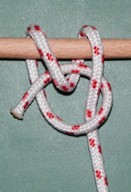 -1 -1
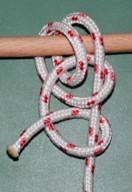 -2 -2
 -3 -3
According to Budworth, "this knot is misleadingly named. It is actually a strong-ish (70-75%) and secure hitch for wet and slimy conditions."
(The Complete Book of Knots,
p.53).
- Gripping Sailor's Hitch
URL: http://daveroot.neocities.org/knots/Knots_Hitches.html#GrippingSailorsHitch
This hitch grips well when tied around another rope, or when tied around a smooth (or tapered) surface such as a rod or a spar. First make several round turns as in picture 1, then bring the end of the rope back towards the left over the tops of the round turns (picture 1). Bring the end of the rope down behind the rod, then bring it between the rod and the main part of the rope (picture 2). Now bring the end of the rope up behind the rod between the rod and the two strands of rope as in picture 3. Dress and set the knot (picture 4). The pull on the rope should be from the left, as in picture 4.
 -1 -1
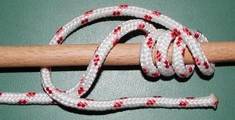 -2 -2
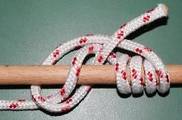 -3 -3
 -4 -4
Also see the
Icicle Hitch
(below).
- Ground Line Hitch or ABOK #277
URL: http://daveroot.neocities.org/knots/Knots_Hitches.html#GroundLineHitch
Later I might add pictures for every hitch and binding knot which is related to the
Clove Hitch
and the
Constrictor Knot
and so on, but for now here's a link to the
Wikipedia article
about the Ground Line Hitch.
- Halter Hitch
See the
Siberian Hitch
(below).
- Highwayman's Hitch
URL: http://daveroot.neocities.org/knots/Knots_Hitches.html#HighwaymansHitch
This is a quick-release hitch which easily comes apart when you pull the end of the rope. To tie this knot, pass a
bight
(a doubled rope) around the object (picture 1), then take the
main
part of the rope and push a
bight
through the first
bight
(picture 2). Now take the
end
of the rope and push a
bight
through the second
bight
(picture 3), and tighten the knot (picture 4). When you need to untie the hitch, simply pull the end of the rope and the quick-release knot will completely fall apart.
 -1 -1
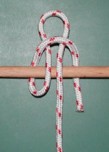 -2 -2
 -3 -3
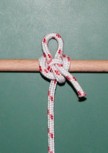 -4 -4
This knot can easily come apart when you pull on the main part of the rope, and therefore it should be avoided. For a better quick-release knot, see the
Tumble Hitch
(below).
- Icicle Hitch
URL: http://daveroot.neocities.org/knots/Knots_Hitches.html#IcicleHitch
Later I might add pictures for every hitch and binding knot which is related to the
Clove Hitch
and the
Constrictor Knot
and so on, but for now here's a link to
an article
about the Icicle Hitch.
Also see the
Gripping Sailor's Hitch
(above).
- Lark's Head Hitch or Cow Hitch or Lanyard Hitch or ABOK #1673
URL: http://daveroot.neocities.org/knots/Knots_Hitches.html#LarksHeadHitch
This is generally considered to be one of the least secure hitches.
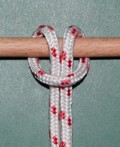
The pull needs to come equally from both ends of the rope in order for this knot to be fairly secure. If the pull will only come from
one
end of the rope then pass the other end of the rope through the hitch to help secure it. This variation is often called the Pedigree Cow Hitch:

If both ends of the rope are already attached to something then you can create the Lark's Head Hitch by using an object as a toggle:
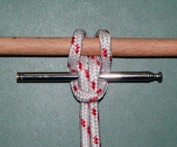
- Miller's Knot or Bag Knot or ABOK #1241, #1242, #1243, #1244
URL: http://daveroot.neocities.org/knots/Knots_Hitches.html#MillersKnot
Later I might add pictures for every hitch and binding knot which is related to the
Clove Hitch
and the
Constrictor Knot
and so on, but for now here's a link to the
Wikipedia article
about the Miller's Knot.
- Ossel Hitch
URL: http://daveroot.neocities.org/knots/Knots_Hitches.html#OsselHitch
Later I might add pictures for every hitch and binding knot which is related to the
Clove Hitch
and the
Constrictor Knot
and so on, but for now here's a link to the
Wikipedia article
about the Ossel Hitch.
- Packer's Knot or Butcher's Knot or ABOK #187
URL: http://daveroot.neocities.org/knots/Knots_Hitches.html#PackersKnot
Later I might add pictures of every binding knot, but for now here's a link to the
Wikipedia article
about the Packer's Knot.
- Pile Hitch or ABOK #1815
URL: http://daveroot.neocities.org/knots/Knots_Hitches.html#PileHitch
If the top of a post is available then you can simply wrap a
bight
of rope (a doubled rope) around the post and then throw the loop over the top of the post.
 -1 -1
 -2 -2
- Rolling Hitch or Magnus Hitch or ABOK #1681
URL: http://daveroot.neocities.org/knots/Knots_Hitches.html#RollingHitch
The Rolling Hitch is similar to the
Clove Hitch
(above), but it's considered to be more secure than the
Clove Hitch.
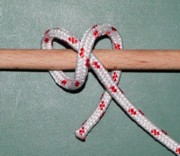 -1 -1
 -2 -2
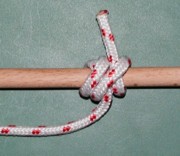 -3 -3
According to Budworth, the pull on the rope needs to be in the direction shown in picture 3
(The Complete Book of Knots,
p.49).
Also see this
Wikipedia article
for some more rolling hitches.
- Round Turn and Two Half Hitches or ABOK #1720
URL: http://daveroot.neocities.org/knots/Knots_Hitches.html#RoundTurnandTwoHalfHitches
This is considered to be a good hitch in most circumstances. Compare this with the
Fisherman's Bend
(above).
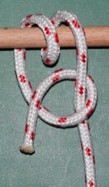 -1 -1
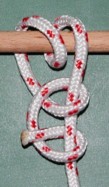 -2 -2
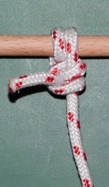 -3 -3
According to Budworth, "The two half-hitches have a breaking strength of 60-75%, but the round turn may increase that percentage."
(The Complete Book of Knots,
p.52).
- Siberian Hitch or Evenk Knot
URL: http://daveroot.neocities.org/knots/Knots_Hitches.html#SiberianHitch
Method #1
Pass the end of the rope around an object, then form a loop and bring the end of the rope to the right behind the two vertical strands of rope as in picture 1. Grab the loop and give it an extra twist, forming an "elbow" (picture 2). Bring the end of the rope to the left, on top of the main part of the rope, then make a
bight
in the end of the rope and push it through the loop (picture 3). This creates a "slipped" Siberian Hitch. Dress and set the knot (picture 4). To tie a Halter Hitch, skip the extra twist in picture 2.
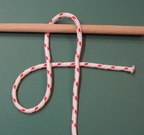 -1 -1
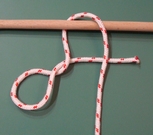 -2 -2
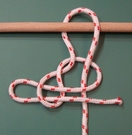 -3 -3
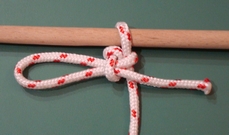 -4 -4
Method #2
For another way to tie the Siberian Hitch, see
Siberian hitch.
There's not a lot of information about the Siberian Hitch or the Halter Hitch out there, but here are some thoughts that I've gathered from various sources: The Siberian Hitch probably provides more security/stability than the Halter Hitch. The
Buntline Hitch
is perhaps more stable than the Siberian Hitch, mainly in situations where the rope will be repeatedly tensioned and released. The Siberian Hitch is easier for some people to tie (especially in cold weather with gloves on) than the
Buntline Hitch,
and it's easier to snug the Siberian Hitch up against an object because both hands tend to be needed in order to work the
Buntline Hitch
all the way up to the object. However, if the tension on the rope is reduced then the Siberian Hitch can relax its grip around the object to some degree, whereas the
Buntline Hitch
tends to maintain its grip around the object even when the tension on the rope is released.
- Sliding Sheet Bend
URL: http://daveroot.neocities.org/knots/Knots_Hitches.html#SlidingSheetBend
This slide-and-grip knot is fairly easy to tie, and it has the added feature of being able to be locked into place. In addition, it's an "exploding" knot because when the end of the rope is pulled, the knot will fall completely apart. This knot is described in greater detail, along with several other "exploding" knots, at
Six Exploding Knots.
To tie this knot, bring the end of the rope around and under itself to form a loop, then place that loop on top of the main part of the rope (picture 1). Now create a
bight
of rope in the end of the rope, then push that
bight
under the main part of the rope and over the other side of the loop, as in picture 2. Dress and set the knot as in picture 3, then slide the knot to the desired position on the main part of the rope. When the knot is in position, hold the knot while pulling the strand of rope which is indicated with a blue arrow in picture 4 (pull the rope in the direction that the arrow is pointing). This will create a "hump" in the main part of the rope, which will lock the knot into place (compare pictures 3 and 4). To unlock the knot in order to slide it up or down the main part of the rope, simply loosen the knot until it looks like picture 3 again.
 -1 -1
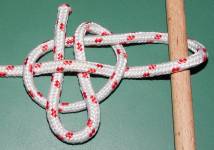 -2 -2
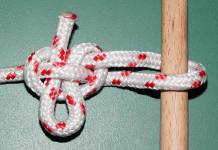 -3 -3
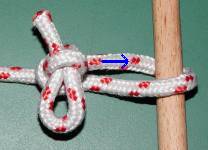 -4 -4
- Snuggle Hitch
URL: http://daveroot.neocities.org/knots/Knots_Hitches.html#SnuggleHitch
Later I might add pictures for every hitch and binding knot which is related to the
Clove Hitch
and the
Constrictor Knot
and so on, but for now here's a link to the
Wikipedia article
about the Snuggle Hitch.
- Strangle Knot or ABOK #1239
URL: http://daveroot.neocities.org/knots/Knots_Hitches.html#StrangleKnot
Later I might add pictures for every hitch and binding knot which is related to the
Clove Hitch
and the
Constrictor Knot
and so on, but for now here's a link to the
Wikipedia article
about the Strangle Knot.
- Tarbuck Knot
URL: http://daveroot.neocities.org/knots/Knots_Hitches.html#TarbuckKnot
This is another slide-and-grip knot. Personally, I find that the
Adjustable Grip Hitch
grips better and is easier to tie and dress and set than the Tarbuck Knot.
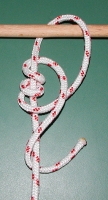 -1 -1
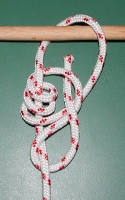 -2 -2
 -3 -3
According to Budworth, "There is only one right way to tie this knot but many wrong ways. Work the entire knot snug before use."
(The Complete Book of Knots,
p.67).
- Tautline Hitch or Midshipman's Hitch or ABOK #1730
URL: http://daveroot.neocities.org/knots/Knots_Hitches.html#TautlineHitch
This is another slide-and-grip knot. Personally, I find that the
Adjustable Grip Hitch
grips better and is easier to tie and dress and set than the Tautline Hitch.
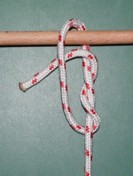 -1 -1
 -2 -2
 -3 -3
- Tumble Hitch
URL: http://daveroot.neocities.org/knots/Knots_Hitches.html#TumbleHitch
This is similar to the
Highwayman's Hitch
(above), but it appears to provide better stability.
Pass a
bight
across the object (picture 1), then make a
bight
in the end of the rope and pass it around the object and through the first
bight
(picture 2). Bring the end of the rope around and on top of the main part of the rope, then bring it over the object just as you passed the first
bight
over the object (picture 3). Make a
bight
in the end of the rope, then pass it through the
bight
which you created in the second picture in the direction shown in picture 4. Carefully dress and set the knot (picture 5). When you pull the "ripcord" (the end of the rope) then the knot will "explode," meaning that the rope will be completely removed from the object.
 -1 -1
 -2 -2
 -3 -3
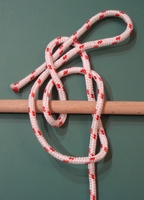 -4 -4
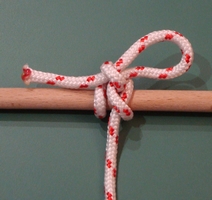 -5 -5
This knot is better suited for non-critical applications (since a tug on the end of the rope could prove disastrous), and for loads which won't put a heavy strain on the rope (since a heavy strain might cause the "ripcord" to become difficult to pull out).
This knot was devised by Dan Lehman, and it's discussed (along with some other quick-release ideas) in the forum topic called
Highwayman's Hitch Improvements
at the International Guild of Knot Tyers.
- Two Half Hitches or ABOK #1710
URL: http://daveroot.neocities.org/knots/Knots_Hitches.html#TwoHalfHitches
This is an example of tying a
Clove Hitch
around the main part of the rope. Compare this with the
Back Hand Hitch,
the
Buntline Hitch,
the
Clove Hitch,
the
Constrictor Knot,
the
Fisherman's Bend,
and the
Round Turn and Two Half Hitches.
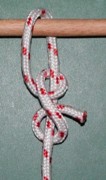 -1 -1
 -2 -2
- Vibration-proof Hitch
URL: http://daveroot.neocities.org/knots/Knots_Hitches.html#Vibration-proofHitch
Later I might add pictures for every hitch and binding knot which is related to the
Clove Hitch
and the
Constrictor Knot
and so on, but for now here's a link to the
Wikipedia article
about the Vibration-proof Hitch.
Summary
A number of hitches are used by sailors, farmers, climbers, etc., for a variety of purposes. But for "basic" purposes, my preferences are the Adjustable Grip Hitch and the Siberian Hitch.
Practice tying your favorite knots periodically (from different angles) so that you'll remember how to tie them when you need them.
For other people's preferred knots, see the forum topics called
"Best of breed" knots?
and
Top ten most useful knots
at the International Guild of Knot Tyers.
"The Most Useful Rope Knots for the Average Person to Know -- Hitches"
URL: http://daveroot.neocities.org/knots/Knots_Hitches.html
Modification History
| 12/15/2010: |
Added the Boa Knot, the Boom Hitch, the Camel Hitch, the Corned Beef Knot, the Halter Hitch, the Ground Line Hitch, the Icicle Hitch, the Miller's Knot, the Ossel Hitch, the Packer's Knot, the Siberian Hitch, the Snuggle Hitch, the Strangle Knot, the Tumble Hitch, and the Vibration-proof Hitch. Added a link to a Wikipedia article for some more rolling hitches. |
| 07/09/2004: |
Added the Sliding Sheet Bend. |
| 12/10/2002: |
New article. |
Dave Root
|
|